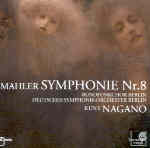This may not be the best-sung Mahler Symphony No. 8 on disc (though it’s very good), but as an artistic conception of the work I have no doubt whatsoever that Kent Nagano’s interpretation represents a veritable landmark in the history of the symphony. No other performance captures more of the music’s mystery and sensuality, revels in the rich details of its orchestration to such a welcome degree, or offers such a clear and characterful distinction between the work’s two parts. What this means, practically speaking, is that Nagano realizes the first movement’s overwhelming polyphonic rhetoric as successfully as he does the second movement’s drama and theatricality, and the result is a feeling of musical completeness, of fulfillment when the work comes to its close, that no rival performance quite matches.
Nagano views the Eighth as a symphony with voices, and not as an oratorio. In other words, the two excellent choirs sound (as placed) from behind the orchestra, and the soloists aren’t unnaturally highlighted. At the biggest moments the instruments and organ (thrillingly captured) tend to dominate, but never at the expense of good balance or reasonable clarity. And unlike so many performances, the choirs really characterize what they sing. Listen, for example, to their pleading tone at “Infirma nostri corporis”. The great double fugue is overwhelming, its anguished climax grinding its way toward a return to Tempo I (a perfectly-judged Allegro impetuoso) so well-timed that it’s positively explosive. The coda also raises the roof, a “joyful noise unto the Lord” in which the concluding rising scales in all of the voices, enlivened by a particularly intelligent accelerando, have a real physical impact. Along the way Nagano reveals numerous details (in the brass parts particularly) that you seldom notice, and which in turn energize the texture.
At about 65 minutes long (the entire performance is just two minutes shy of an hour and a half), this performance of Part 2 ranks with the slowest on disc, but the extra time is deceptive. Nagano spends most of it in the opening stages (up to the entrance of Pater profundis) and in the concluding Chorus mysticus. This has profound structural implications, creating a clearly delineated musical frame within which the more lively (and very vividly contrasted) events of Goethe’s drama take place. I don’t think anyone has created a more tangible sense of mystery in the opening Poco adagio than Nagano achieves here; for once the ensuing “chorus and echo” really sounds like one–the atmosphere is palpable. The tempo then increases steadily, imperceptibly, until the entrance of the women and the (particularly ethereal) boys offers a dazzling burst of light. Nagano revels in these “heavenly” episodes, shamelessly milking the luminous writing for harps, celesta, piano, and mandolins. The interlude describing the first appearance of the Mater gloriosa, for example, lingers over every luscious detail of the scoring. Nagano knows how to give the music meaning, and he makes it matter, inviting us to leave questions of “good taste” behind and care about it as much as he does.
When it comes to the solo contributions, on the whole the men are a bit better than the women. Tenor Robert Gambill does a surprisingly good job in the all-but-impossible role of Dr. Marianus, and bass Jan-Hendrik Rootering is a particulary strong Pater profundis. Among the women, Lynne Dawson’s Gretchen doesn’t come close to Edith Mathis (for Kubelik), but the others are all more than adequate. Sally Matthews’ very distant, barely audible Mater gloriosa is just right, a heavenly voice from above rather than a soprano in extremis stuck in a balcony somewhere. From “Blicket auf” onward, the performance is so exquisitely beautiful that it’s impossible to describe. Among existing recordings, the sheer loveliness of texture recalls Sinopoli, but with none of his rhythmic slackness and sloppiness. The Chorus mysticus, taken very slowly, returns once again to the atmosphere of the movement’s opening Poco adagio, definitely conveying the sense that “the drama is now over”.
Sonically, this is without question the best recording of the symphony ever made. It gives a very realistic impression of huge forces gathered in a large space, capturing plenty of room acoustic without significant loss of clarity. The closing pages are overwhelming, undistorted and uncongested. I can’t wait to hear this in SACD surround format. Despite all of these clear advantages, I find this a difficult release to rate. Among modern performances Chailly clearly has the better singers overall, but his conception doesn’t compare to Nagano’s vision of the work. I wouldn’t want to live without either of them. So if the singing matters to you most, Chailly is your man (or Kubelik on Audite); but if you want the most interpretively insightful and moving rendition of the piece on disc, you will have to hear this. It’s that special, and the truly elegant, first-class packaging and presentation only makes it more so. [5/2/2005]
































